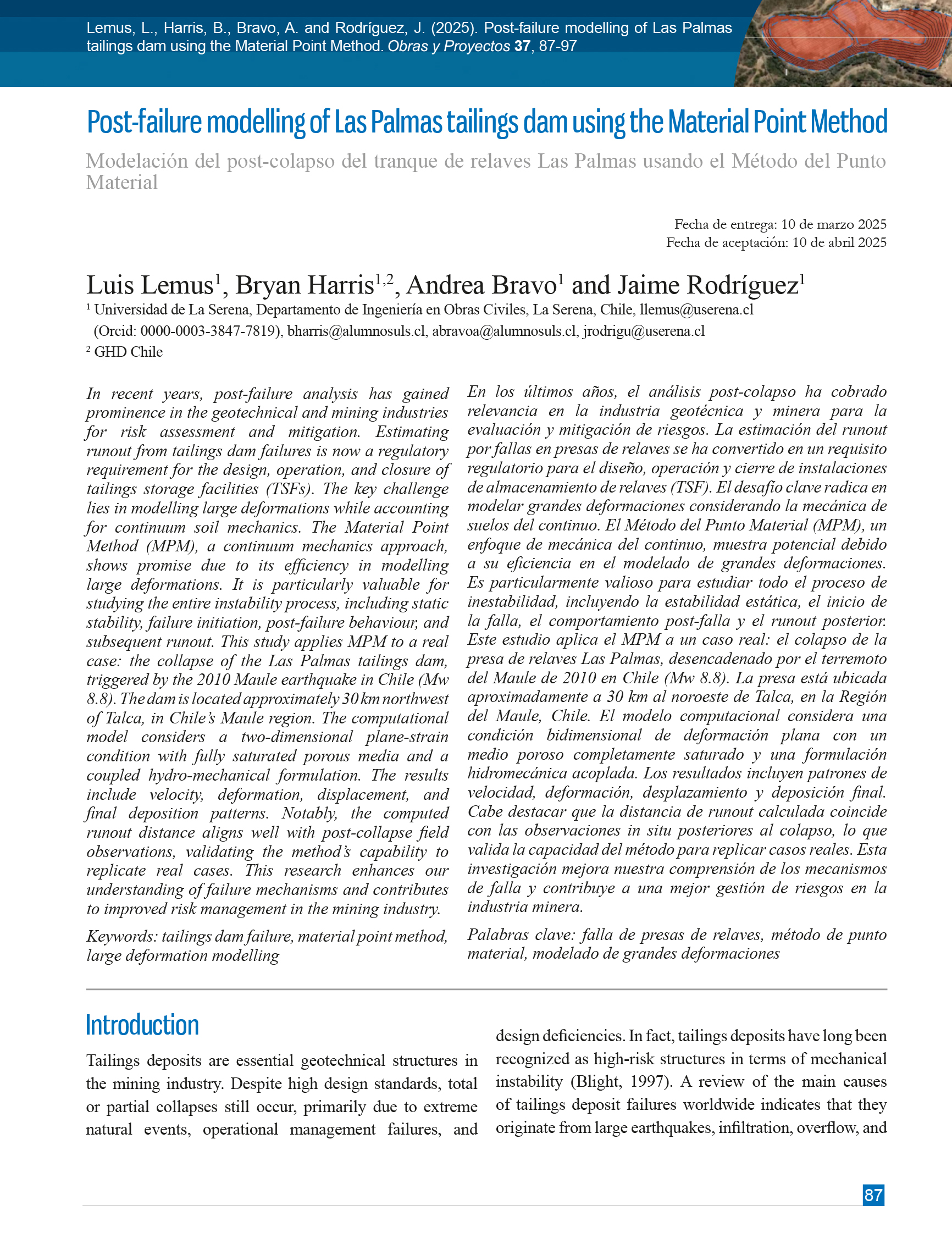Modelación del post-colapso del tranque de relaves Las Palmas usando el Método del Punto Material
DOI:
https://doi.org/10.21703/0718-2813.2025.37.3240Palabras clave:
Falla de presas de relaves, Método de punto material, Modelado de grandes deformacionesResumen
En los últimos años, el análisis post-colapso ha cobrado relevancia en la industria geotécnica y minera para la evaluación y mitigación de riesgos. La estimación del runout por fallas en presas de relaves se ha convertido en un requisito regulatorio para el diseño, operación y cierre de instalaciones de almacenamiento de relaves (TSF). El desafío clave radica en modelar grandes deformaciones considerando la mecánica de suelos del continuo. El Método del Punto Material (MPM), un enfoque de mecánica del continuo, muestra potencial debido a su eficiencia en el modelado de grandes deformaciones. Es particularmente valioso para estudiar todo el proceso de inestabilidad, incluyendo la estabilidad estática, el inicio de la falla, el comportamiento post-falla y el runout posterior. Este estudio aplica el MPM a un caso real: el colapso de la presa de relaves Las Palmas, desencadenado por el terremoto del Maule de 2010 en Chile (Mw 8.8). La presa está ubicada aproximadamente a 30 km al noroeste de Talca, en la Región del Maule, Chile. El modelo computacional considera una condición bidimensional de deformación plana con un medio poroso completamente saturado y una formulación hidromecánica acoplada. Los resultados incluyen patrones de velocidad, deformación, desplazamiento y deposición final. Cabe destacar que la distancia de runout calculada coincide con las observaciones in situ posteriores al colapso, lo que valida la capacidad del método para replicar casos reales. Esta investigación mejora nuestra comprensión de los mecanismos de falla y contribuye a una mejor gestión de riesgos en la industria minera.
Referencias
Anura3D (2022). MPM Research Community. https://github.com/Anura3D/Anura3D_OpenSource
Azam, S. and Li, Q. (2010). Tailings dam failures: a review of the last one hundred years. Geotechnical News/Waste Geotechnics, 50-53.
Blight, G. (1997). Destructive mudflows as a consequence of tailings dyke failures. Proceedings of the ICE – Geotechnical Engineering 125(1), 9–18.
Bray, J.D. and Frost, J.D. (eds.) (2010). Geo-engineering Reconnaissance of the 2010 Maule, Chile Earthquake. Geoengineering Extreme Events Reconnaissance GEER Association, Report No. GEER-022, USA.
Castro, G. and Troncoso, J. (1989). Effects of 1985 Chilean earthquake on three tailing dams. Fifth Chilean Conference on Seismology and Earthquake Engineering, Santiago, Chile.
Concha, P. and Lall, U. (2018). Tailings dams failures: Updated statistical model for discharge volume and runout. Environments 5(2), 28.
Davies, M.P. (2002). Tailings impoundment failures: are geotechnical engineers listening?. Geotechnical News/Waste Geotechnics, 31–36.
Dobry, R. and Alvarez, L. (1967). Seismic failures of Chilean tailings dams. Journal of the Soil Mechanics and Foundations Division 93(6), 237–260.
Elkhamra, Y., Chen, H. and Stark, T. (2023). Inverse analysis of Cadia tailings dam failure. Geo-Congress 2023, E. Rathje, B.M. Montoya and M.H. Wayne (eds.), ASCE and GI, Los Angeles, CA, USA, 10-19.
Fern, J., Rohe, A., Soga, K. and Alonso, E. (eds.). (2019). The Material Point Method for Geotechnical Engineering: A Practical Guide. CRC Press, Taylor & Francis Group, Boca Raton, USA.
GEER (2010). Dams, levees, and mine tailings dams. Turning disaster into knowledge: geo-engineering reconnaissance of the 2010 Maule, Chile Earthquake. Geo-Engineering Extreme Events Reconnaissance Association GEER. J. Bray and D. Frost (eds.), 204–226.
Gebhart, T.R. (2016). Post-liquefaction residual strength assessment of the Las Palmas, Chile tailings failure. MSc thesis, California Polytechnic State University, San Luis Obispo, USA.
Ghahramani, N., Chen, H.J., Clohan, D., Liu, S., LlanoSerna, M., Rana, N.M., McDougall, S., Evans, S.G. and Take, W.A. (2022). A benchmarking study of four numerical runout models for the simulation of tailings flows. Science of the Total Environment 827, 154245.
Hernández, A.B. (2021). Colapso del tranque de relaves Las Palmas durante el sismo del Maule 2010. Tesis de magíster, P. Universidad Católica de Chile, Macul, Chile.
Hungr, O. (1995). A model for the runout analysis of rapid flow slides, debris flows, and avalanches. Canadian Geotechnical Journal 32(4), 610–623.
ICOLD (2001). Tailings dams - risk of dangerous occurrences, lessons learnt from practical experiences. Bulletin 121. United Nations Environmental Programme (UNEP), Division of Technology, Industry and Economics (DTIE) and International Commission on Large Dams (ICOLD), Paris, France.
Ishihara, K., Ueno, K., Yamada, S., Yasuda, S. and Yoneoka, T. (2015). Breach of a tailings dam in the 2011 earthquake in Japan. Soil Dynamics and Earthquake Engineering 68, 3–22.
Jassim, I., Stolle, D. and Vermeer, P. (2013). Two-phase dynamic analysis by material point method. International Journal for Numerical and Analytical Methods in Geomechanics 37(15), 2502–2522.
Jeyapalan, J.K., Duncan, J.M., Seed, H.B. (1981). Summary of research on analyses of flow failures of mine tailings impoundment. Information Circular 8857, Technology Transfer Workshop on Mine Waste Disposal Techniques, US Bureau of Mines, Denver, CO, USA, 54–61.
Jeyapalan, J.K., Duncan, J.M. and Seed, H.B. (1983). Analyses of flow failures of mine tailings dams. Journal of Geotechnical Engineering 109(2), 150–171.
Kossoff, D., Dubbin, W.E., Alfredsson, M., Edwards, S.J., Macklin, M.G., Hudson-Edwards, K.A. (2014). Mine tailings dams: characteristics, failure, environmental impacts, and remediation. Applied Geochemistry 51, 229–245.
Lemus, L., Rodríguez, J., Cáceres, V. y Mery, D. (2024). Modelación computacional de deslizamientos de tierra masivos inducidos por sismos usando el Método del Punto Material. Obras y Proyectos 35, 31-39.
Lucia, P.C., Duncan, J.M. and Seed, H.B. (1981). Summary of research on case histories of flow failures of mine tailings impoundments. Technology Transfer Workshop on Mine Waste Disposal Techniques, US Bureau of Mines, Denver, CO, USA, 46-53.
Lumbroso, D., Davison, M., Body, R. and Petkovšek, G. (2021). Modelling the Brumadinho tailings dam failure, the subsequent loss of life and how it could have been reduced. Natural Hazards and Earth System Science 21, 21–37.
Macedo, J., Yerro, A., Cornejo, R. and Pierce, I. (2024). Cadia TSF failure assessment considering triggering and posttriggering mechanisms. Journal of Geotechnical and Geoenvironmental Engineering 150(4), 04024011.
Moss, R.E.S., Gebhart T.R., Frost J.D. and Ledezma C. (2019). Flow-failure case history of the Las Palmas, Chile, tailings dam. Pacific Earthquake Engineering Research Center PEER report 2019/01. UC Berkeley, USA.
Piciullo, L., Storrøsten, E.B., Liu, Z., Nadim, F. and Lacasse, S. (2022). A new look at the statistics of tailings dam failures. Engineering Geology 303, 106657.
Pinyol, N.M., Alvarado, M., Alonso, E.E. and Zabala, F. (2017). Thermal effects in landslide mobility. Géotechnique 68(6), 528-545.
Pizarro, G., Pastén, P., Bonilla, C., Tarud, F. y Acevedo, S. (2010). Evaluación preliminar de contingencia en tranque de relaves Las Palmas, Sector Pencahue, Región del Maule. DICTUC, Macul, Chile.
Quilodrán, C.A. (2021). Distancia peligrosa tranque de relaves Las Palmas. Tesis de magíster, P. Universidad Católica de Chile, Macul, Chile.
Rico, M., Benito G., Salgueiro A.R., Díez-Herrero A. and Pereira H.G. (2008a). Reported tailings dam failures a review of the European incidents in the worldwide context. Journal of Hazardous Materials 152(2) 846–852.
Rico, M., Benito G. and Díaz-Herrero A. (2008b). Floods from tailings dam failures. Journal of Hazardous Materials 154(1-3), 79–87.
Soga, K., Alonso, E., Yerro, A., Kumar, K. and Bandara, S. (2016). Trends in large-deformation analysis of landslide mass movements with particular emphasis on the material point method. Géotechnique 66(3), 248–273.
Sulsky, D., Chen, Z. and Schreyer, H.L. (1994). A particle method for hystory-dependent materials. Computer Methods in Applied Mechanics and Engineering 118(1-2), 179–196.
Sulsky, D., Zhou, S.J. and Schreyer, H.L. (1995). Application of a particle-in-cell method to solid mechanics. Computer Physics Communications 87(1-2), 236–252.
Van Zyl, D. (2014). Plenary Presentation: Holistic approach to mine waste management. 2nd International Seminar on Tailings Management, Gecamin: Tailings 2014, Antofagasta, Chile Verdugo, R. and González, J. (2015). Liquefaction-induced ground damages during the 2010 Chile earthquake. Soil Dynamics and Earthquake Engineering 79, 280–295.
Verdugo, R., Sitar, N., Frost, J.D., Bray, J.D., Candia, G., Eldridge, T., Hashash, Y., Olson, S.M. and Urzua, A. (2012). Seismic performance of earth structures during the February 2010 Maule, Chile, earthquake: dams, levees, tailings dams, and retaining walls. Earthquake Spectra 28(1), 75-96.
Verdugo, R., Villalobos, F., Yasuda, S., Konagai, K., Sugano, T., Okamura, M., Tobita, T. and Torres, A. (2010). Description and analysis of geotechnical aspects associated to the large 2010 Chile earthquake. Obras y Proyectos 8, 25-36.
Villavicencio, G., Espinace, R., Palma, J., Fourie, A. and Valenzuela, P. (2014). Failures of sand tailings dams in a highly seismic country. Canadian Geotechnical Journal 51(4), 449–464.
Yerro, A., Alonso, E. and Pinyol, N. (2013). The Material Point Method: A promising computational tool in Geotechnics. 18th International Conference on Soil Mechanics and Geotechnical Engineering, Paris, France, 853–856.
Zabala, F. and Alonso, E.E. (2011). Progressive failure of Aznalcóllar dam using the material point method. Géotechnique 61(9), 795–808.
Zienkiewicz, O.C. and Shiomi, T. (1984). Dynamic behaviour of saturated porous media: the generalized Biot formulation and its numerical solution. International Journal for Numerical and Analytical Methods in Geomechancs 8(1), 71–96.

Descargas
Publicado
Número
Sección
Licencia
Derechos de autor 2025 Universidad Católica de la Santísima Concepción

Esta obra está bajo una licencia internacional Creative Commons Atribución-NoComercial 4.0.







